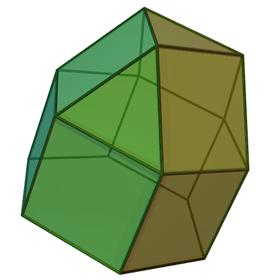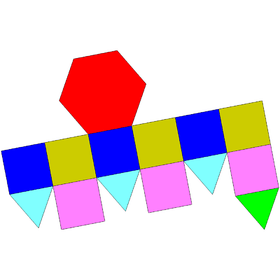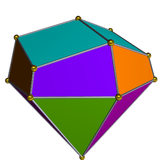Elongated triangular cupola
| Elongated triangular cupola | |
|---|---|
 | |
| Type |
Johnson J17 - J18 - J19 |
| Faces |
1+3 triangles 3.3 squares 1 hexagon |
| Edges | 27 |
| Vertices | 15 |
| Vertex configuration |
6(42.6) 3(3.4.3.4) 6(3.43) |
| Symmetry group | C3v |
| Dual polyhedron | - |
| Properties | convex |
| Net | |
 | |
In geometry, the elongated triangular cupola is one of the Johnson solids (J18). As the name suggests, it can be constructed by elongating a triangular cupola (J3) by attaching a hexagonal prism to its base.
A Johnson solid is one of 92 strictly convex polyhedra that have regular faces but are not uniform (that is, they are not Platonic solids, Archimedean solids, prisms or antiprisms). They were named by Norman Johnson, who first listed these polyhedra in 1966.[1]
Formulae
The following formulae for volume and surface area can be used if all faces are regular, with edge length a:[2]


Dual polyhedron
The dual of the elongated triangular cupola has 15 faces: 6 isosceles triangles, 3 rhombi, and 6 quadrilaterals.
| Dual elongated triangular cupola | Net of dual |
|---|---|
 |
 |
Related polyhedra and honeycombs
Johnson solid No.18(Elongated triangular cupola) fill the space with Tetrahedron and Johnson solid No.1(Square pyramid).[3]
References
- ↑ Johnson, Norman W. (1966), "Convex polyhedra with regular faces", Canadian Journal of Mathematics 18: 169–200, doi:10.4153/cjm-1966-021-8, MR 0185507, Zbl 0132.14603.
- ↑ Stephen Wolfram, "Elongated triangular cupola" from Wolfram Alpha. Retrieved July 22, 2010.
- ↑ http://woodenpolyhedra.web.fc2.com/J18.html
External links
- Weisstein, Eric W., "Johnson solid", MathWorld.
- Weisstein, Eric W., "Elongated triangular cupola", MathWorld.